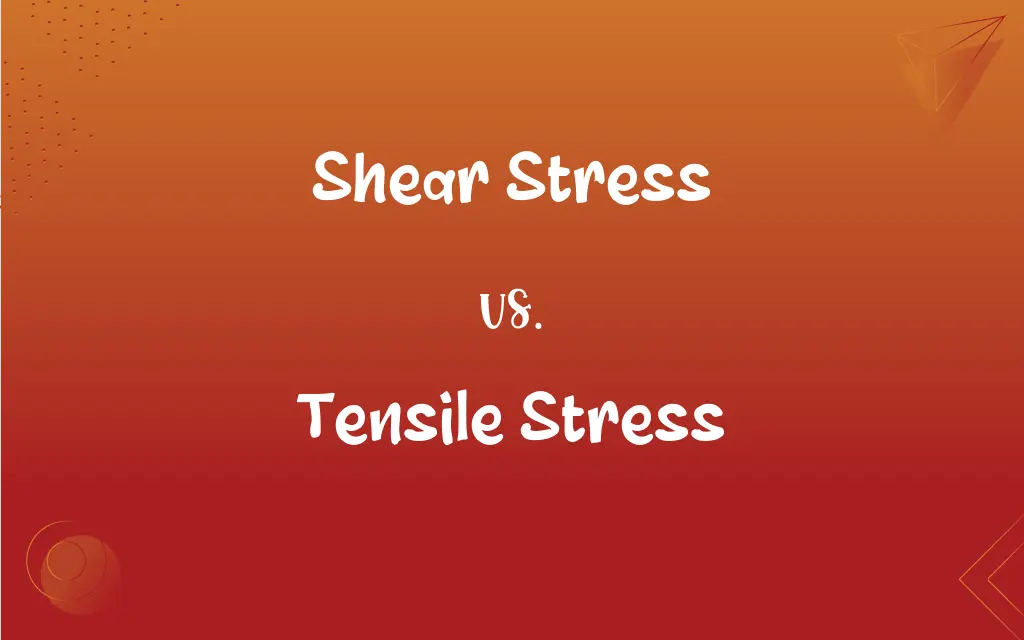Shear Stress vs. Tensile Stress: What's the Difference?
Edited by Aimie Carlson || By Janet White || Published on November 29, 2023
Shear stress is the force per unit area causing layers to slide past each other, while tensile stress is the stretching force per unit area.

Key Differences
Shear stress occurs when forces are applied parallel to a material's surface, causing layers to slide over each other. In contrast, tensile stress stretches material by pulling it apart along its length.
Shear stress is often observed in materials subjected to twisting or shearing forces. Tensile stress, however, is seen in materials under tension, like ropes or cables.
The effect of shear stress can lead to deformations where the material shape changes without volume change. Tensile stress can elongate materials and may lead to a volume increase.
In engineering, managing shear stress is crucial for the integrity of structures like beams. Tensile stress is vital in applications where materials must withstand pulling forces, like in bridges.
Shear stress can cause failure along planes parallel to the force. Tensile stress may result in material failure due to fracturing under excessive stretching.
ADVERTISEMENT
Comparison Chart
Force Direction
Parallel to material's surface
Along the material's length
Common Observation
In twisting or shearing situations
In materials under tension, like ropes
Deformation Type
Sliding layers, shape change
Elongation, potential volume increase
Engineering Importance
Crucial for beams and similar structures
Essential for structures under pulling forces
Failure Mode
Failure along parallel planes
Fracturing under excessive stretching
ADVERTISEMENT
Shear Stress and Tensile Stress Definitions
Shear Stress
Shear stress leads to the sliding of layers within a material.
The shear stress caused the deck layers to slip and crack.
Tensile Stress
Tensile stress can lead to material elongation.
Under tensile stress, the metal rod elongated slightly.
Shear Stress
Shear stress is critical in the design of shear walls in buildings.
Engineers calculated the shear stress to ensure the stability of the shear wall.
Tensile Stress
Tensile stress is a key factor in testing material strength.
Material testing often measures tensile stress to determine strength.
Shear Stress
Shear stress occurs in materials under twisting forces.
The shaft experienced shear stress during rotation.
Tensile Stress
Tensile stress can cause failure in materials due to stretching.
The rope broke due to excessive tensile stress.
Shear Stress
Shear stress is the stress caused by forces parallel to a surface.
Shear stress in the beam increased as the load on the overhang grew.
Tensile Stress
Tensile stress is the stretching force per unit area in a material.
The cable's tensile stress increased with the added weight.
Shear Stress
Shear stress can lead to shear failure in materials.
The material underwent shear failure due to excessive shear stress.
Tensile Stress
Tensile stress occurs when a material is pulled or stretched.
Tensile stress in the bridge's cables was carefully monitored.
FAQs
What is shear stress?
Stress caused by parallel forces in a material.
What type of deformation does shear stress cause?
Sliding layers, changing shape without volume change.
What defines tensile stress?
Stress from a stretching force in a material.
How does tensile stress affect materials?
Causes elongation and potential volume increase.
How can shear stress lead to material failure?
Failure along planes parallel to the force.
Where is shear stress commonly found?
In materials under twisting or shearing forces.
In what applications is tensile stress important?
In structures under tension like cables and ropes.
What units are used to measure tensile stress?
Typically in Pascals or pounds per square inch.
Why is shear stress important in engineering?
It's critical for the integrity of structures like beams.
What role does tensile stress play in bridge construction?
Essential for withstanding pulling forces in bridges.
What failure can occur due to tensile stress?
Material fracturing under excessive stretching.
Can shear stress be visually observed?
Often noticeable by deformation or twisting.
What happens to materials under high tensile stress?
They can break or fracture if overextended.
What is a shear stress test?
A test to determine a material's resistance to parallel forces.
Can shear and tensile stresses occur simultaneously?
Yes, in many real-world applications, both stresses can be present at once.
Are materials equally resistant to shear and tensile stress?
Resistance varies based on material properties and stress type.
How do engineers mitigate shear stress in construction?
By designing elements like shear walls and reinforcements.
What is a tensile stress test?
A test measuring a material's strength under stretching.
How is shear stress measured?
Calculated based on parallel force and area.
Why is monitoring tensile stress in cables crucial?
To prevent stretching beyond the material's capacity.
About Author
Written by
Janet WhiteJanet White has been an esteemed writer and blogger for Difference Wiki. Holding a Master's degree in Science and Medical Journalism from the prestigious Boston University, she has consistently demonstrated her expertise and passion for her field. When she's not immersed in her work, Janet relishes her time exercising, delving into a good book, and cherishing moments with friends and family.
Edited by
Aimie CarlsonAimie Carlson, holding a master's degree in English literature, is a fervent English language enthusiast. She lends her writing talents to Difference Wiki, a prominent website that specializes in comparisons, offering readers insightful analyses that both captivate and inform.

































































